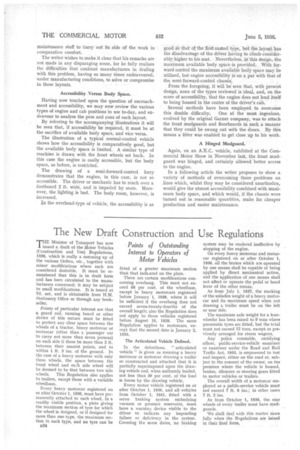The New Draft Construction and Use Regulations
Page 44

If you've noticed an error in this article please click here to report it so we can fix it.
Points of Outstanding Interest to Operators of Motor Vehicles
TIE Minister of Transport has now issued a draft of the Motor Vehicles (Construction and Use) Regulations. 1936, which is really a summing up of the various Orders, etc., together with minor modifications where such are considered desirable. It must be remembered that this is in draft form and has been circulated to the manufacturers concerned; it may be subject to small modifications. It is issued at 7d. net, and is obtainable from H.M. Stationery Office or through any bookseller.
Points of particular interest are that a guard rail, running board or other device of this nature must be fitted to protect any clear space between the wheels of a tractor, heavy motorcar or motorcar (other than a passenger car to carry not more than seven persons) on each side it there be more than 2 ft. between their nearest points, and to within 1 ft. 3 ins, of the ground. In the case of a heavy motorcar with only three wheels, the space between the front wheel and each side wheel will be deemed to be that between two side wheels. This Regulation also applies to trailers, except those with a variable wheelbase.
Every heavy motorcar registered on or after October 1, 1936, must have permanently attached to each wheel, in a readily visible position, a plate giving the maximum section of tyre for which the wheel is designed, or if designed for more than one type, the maximum section in each type, and no tyre can be
n34
fitted of a greater maximum section than that indicated on the plate.
There are certain modifications concerning overhang. This must not exceed 50 per cent, of the wheelbase, except in heavy motorcars registered before January 1, 1938, where it will be sufficient if the overhang does not exceed seven-twenty-fourths of the overall length; also the Regulation does not apply to those vehicles registered before August 15, 1928. The same Regulation applies to motorcars, except that the second date is January 2, 1933.
The Articulated Vehicle Defined.
In the definitions, "articulated vehicle" is given as meaning a heavy motorcar or motorcar drawing a trailer so constructed and attached that it is partially superimposed upon the drawing vehicle and, when uniformly loaded, not less than 30 per cent, of the load is borne by the drawing vehicle.
Every motor vehicle registered on or after October 1, 1936, and all vehicles from October 1, 1941, fitted with a servo braking system embodying vacuum or pressure reservoirs, must have a warninq device visible to the driver to indicate any impending failure or deficiency in the system. Covering the same dates, no braking system may be rendered ineffective by stopping of the engine.
On every heavy motorcar and motorcar registered on or after October 1, 1936, all the brakes which are operated by one means shall be capable of being applied by direct mechanical action, and the application of one means shall not affect or operate the pedal or hand lever of the other means.
As from July 1, 1937, the marking of the unladen weight of a heavy motorcar and itsmaximum speed when not drawing a trailer must be on the left or near side.
The maximum axle weight for a fourwheeler has been raised to 9 tons where pneumatic tyres are fitted, but the total must not exceed 12 tons, except as previously arranged for steam wagons.
Any police constable, certifying officer, public-service-vehicle examiner or examiner under the Road and Rail Traffic Act, 1933, is empowered to test and inspect, either on the road or, subject to the consent of the owner, on the premises where the vehicle is housed, brakes, silencers or steering gears fitted to motor vehicles or trailers.
The overall width of a motorcar employed as a public-service vehicle must not exceed 7 ft. 6 ins.; in other cases 7 ft. 2 ins.
As from October 1, 1936, the rear wheels of every trailer must have mudguards.
We shall deal with this matter More fully when the Regulations are isSued in their final form.




















































































